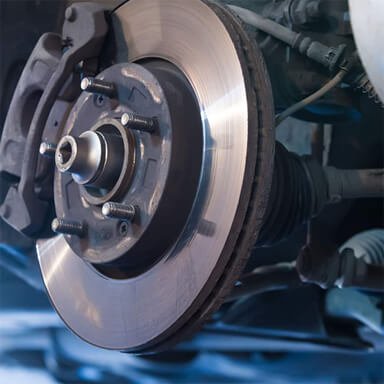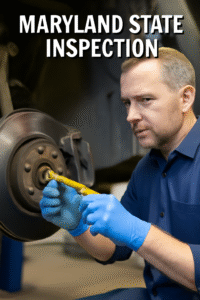Contacts Us
Have a Question?

Maryland State Inspection

What is the Maryland State Vehicle Inspection?
The Maryland State Vehicle Inspection is a safety inspection required by the state for any vehicle that is sold, transferred, or registered in Maryland. The purpose of this inspection is to ensure that the vehicle is safe to operate and meets Maryland’s safety standards. The inspection helps to identify issues that could compromise vehicle safety, such as defective brake systems, improperly functioning lights, or worn-out tires. This inspection is typically required when you buy a used car, when you are registering a vehicle that was previously registered out of state, or when you renew your vehicle’s registration after a certain period.
The Importance of the Maryland State Inspection
The Maryland State Inspection is crucial for the following reasons:
Vehicle Safety: Ensuring your vehicle meets safety standards is essential to keeping you, your passengers, and other drivers on the road safe.
Legal Compliance: Maryland law requires all vehicles to pass a safety inspection to be registered. If your vehicle fails, you won’t be able to legally drive it until the necessary repairs are made.
Preserving Vehicle Integrity: The inspection also helps to catch minor issues before they turn into major, costly repairs.
Insurance and Financial Peace of Mind: A passing inspection means your car is more likely to meet the requirements of your insurance policy, making sure you’re covered in the event of an accident.
What Happens During a Maryland State Vehicle Inspection?
During the Maryland State Inspection, a licensed inspection station performs a series of checks to ensure that your car meets the state’s safety standards. The inspection is fairly comprehensive and covers various components of your vehicle, including its frame, lights, tires, brakes, and more. The inspection is usually performed by a certified Maryland State Police (MSP) inspector or a professional at a certified inspection station.
Here’s a breakdown of the steps an inspector takes during a Maryland State Inspection:
1. Vehicle Identification Check
Before anything else, the inspector will verify the Vehicle Identification Number (VIN) to make sure it matches the vehicle’s title and registration documents. This step is important to confirm the vehicle’s identity and to ensure that it hasn’t been tampered with.
2. Exterior Inspection
The inspector will then conduct a visual examination of the vehicle’s exterior. This includes checking for:
Windshield and Windows: The inspector will ensure that the windshield is free from cracks or other damage that could impair visibility. They will also check that all windows function properly and that window tint meets the state’s legal limits.
Lights and Reflectors: The inspector checks that all lights, including headlights, tail lights, brake lights, turn signals, and hazard lights, are working correctly. They will also ensure that reflectors are present and visible.
Mirrors: The vehicle must be equipped with functional side mirrors and a rearview mirror. The inspector will check to ensure they are not broken or missing.
Windshield Wipers: Wiper blades must be in good condition, and the vehicle must have a working washer system to ensure clear visibility during adverse weather conditions.
3. Underbody and Frame Inspection
The inspector will check the undercarriage of the vehicle for signs of damage, rust, or corrosion that could compromise the structural integrity of the car. If the frame is damaged or weakened, it could affect the vehicle’s ability to handle certain impacts.
4. Brake System Evaluation
The brake system is one of the most critical components of vehicle safety, and the inspector will pay close attention to it. They will:
Check the Brake Pads: Brake pads are inspected for wear. If the brake pads are too thin, they will need to be replaced.
Inspect Brake Lines and Hoses: The inspector will check for any visible leaks or cracks in the brake lines and hoses that could reduce braking efficiency.
Test the Parking Brake: The parking brake must be functional and hold the vehicle in place when engaged. The inspector will test it to ensure it works correctly.
Examine Brake Fluid: The inspector will also ensure that the brake fluid is at the proper level and free of contamination.
5. Tire Condition and Alignment Check
Tires are essential for vehicle stability and safe operation. The inspector will examine the tires for:
Tire Tread Depth: Tires with worn-out treads can be dangerous, particularly in wet or icy conditions. The inspector will use a tread depth gauge to ensure the tires meet the minimum safety requirement.
Tire Pressure: Proper tire pressure is essential for vehicle handling, fuel efficiency, and safety. The inspector will check that each tire is properly inflated.
Tire Alignment: The inspector will also check the vehicle’s alignment to make sure the tires are properly aligned, which affects steering and tire wear.
6. Suspension and Steering System Inspection
The inspector will also examine the suspension system to ensure that the vehicle is capable of absorbing shocks and maintaining stability. They will check the following:
Shock Absorbers and Struts: Worn-out shocks or struts can affect ride quality and handling. The inspector will look for any visible signs of damage or leakage.
Steering Components: The steering system is checked for proper functionality. Loose steering or steering wheel vibration may indicate issues.
7. Exhaust and Emission System Test
The vehicle’s exhaust system must be in good condition to ensure that emissions are properly filtered and that harmful gases are not leaking into the cabin. The inspector will check for:
Exhaust Leaks: Any holes or cracks in the exhaust system can allow dangerous fumes to enter the cabin.
Catalytic Converter: The catalytic converter helps reduce harmful emissions, and it must be in working condition for the vehicle to pass inspection.
8. Battery and Electrical System Inspection
The battery is checked for secure placement and clean terminals, ensuring that the electrical system functions properly. The inspector will look for signs of corrosion or leakage from the battery.
9. Test Drive
In some cases, the inspector may take the vehicle for a short test drive to ensure the vehicle performs properly while driving. During the test, they will check for any unusual noises or issues with handling, such as pulling to one side or rough shifting.
What Happens After the Inspection?
Once the inspection is complete, the inspector will provide you with a Maryland State Inspection certificate if your vehicle passes. If any repairs are necessary, you will be given a detailed list of the issues that need to be addressed before the car can pass the inspection.
Common Reasons for Failing the Maryland State Inspection
While it’s certainly possible to pass the Maryland State Inspection with a well-maintained vehicle, there are several common reasons why cars fail:
Worn-out or underperforming brake pads or rotors
Bald or damaged tires
Broken or malfunctioning lights
Rust or damage to the vehicle’s frame
Exhaust leaks or malfunctioning emission systems
Conclusion
The Maryland State Vehicle Inspection is an essential part of maintaining road safety and ensuring that all vehicles meet the state’s safety standards. While it might seem like a hassle, it’s important to remember that these inspections are for your protection. By knowing what’s involved and taking the time to properly maintain your vehicle, you can increase the chances of passing the inspection on the first try and keep your vehicle operating safely for years to come.